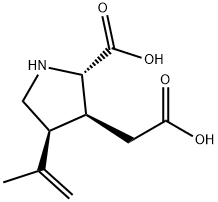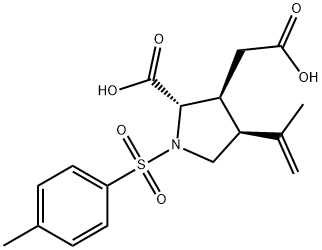
KAINIC ACID
- Product NameKAINIC ACID
- CAS487-79-6
- CBNumberCB2351306
- MFC10H15NO4
- MW213.23
- MDL NumberMFCD00077806
- MOL File487-79-6.mol
- MSDS FileSDS
Chemical Properties
| Melting point | 253-254 C |
| alpha | D24 -14.8° (c = 1.01) |
| Boiling point | 353.22°C (rough estimate) |
| Density | 1.2177 (rough estimate) |
| refractive index | 1.4368 (estimate) |
| storage temp. | Keep in dark place,Sealed in dry,2-8°C |
| solubility | H2O: soluble |
| form | White to off-white solid. |
| pka | 2.03±0.60(Predicted) |
| color | White |
| optical activity | -14.824 (H2O) |
| Water Solubility | Soluble to 25 mM in water |
| Stability | Stable for 1 year from date of purchase as supplied. Solutions in distilled water may be stored at -20° for up to 3 months. |
| InChI | InChI=1S/C10H15NO4/c1-5(2)7-4-11-9(10(14)15)6(7)3-8(12)13/h6-7,9,11H,1,3-4H2,2H3,(H,12,13)(H,14,15)/t6-,7+,9-/m0/s1 |
| InChIKey | VLSMHEGGTFMBBZ-OOZYFLPDSA-N |
| SMILES | N1C[C@H](C(C)=C)[C@H](CC(O)=O)[C@H]1C(O)=O |
| FDA UNII | SIV03811UC |
| EPA Substance Registry System | 3-Pyrrolidineacetic acid, 2-carboxy-4-(1-methylethenyl)-, (2S,3S,4S)- (487-79-6) |
Safety
| Symbol(GHS) |

|
| Signal word | Warning |
| Hazard statements | H302-H312-H332 |
| Precautionary statements | P261-P264-P270-P271-P280-P301+P312-P302+P352-P304+P340-P330-P363-P501 |
| Hazard Codes | Xn |
| Risk Statements | 20/21/22 |
| Safety Statements | 22-24/25-36 |
| WGK Germany | 3 |
